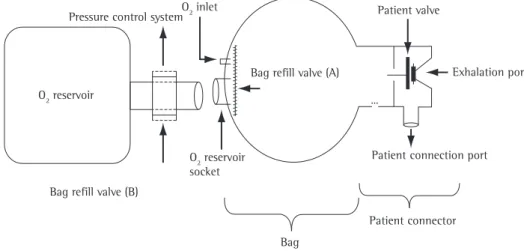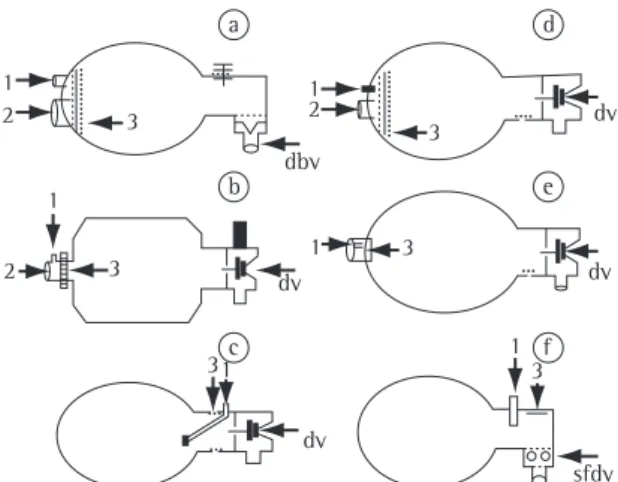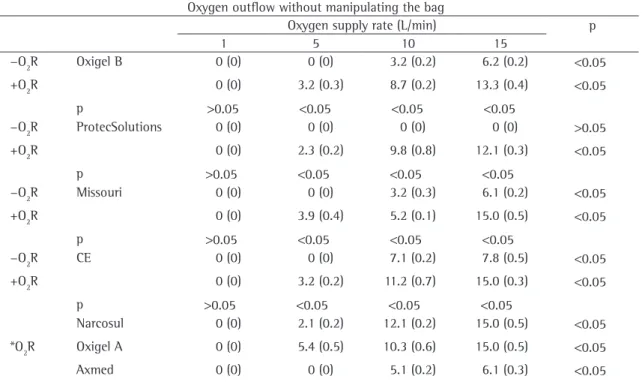* Study carried out at the Universidade Estadual de Campinas – Unicamp, State University at Campinas – School of Medicine Hospital das Clínicas, Campinas, Brazil. 1. Physical Therapist in the Emergency Department. Universidade Estadual de Campinas – Unicamp, State University at Campinas – School of Medicine Hospital das Clínicas, Campinas, Brazil.
2. Head of the Emergency Department. Universidade Estadual de Campinas – Unicamp, State University at Campinas – School of Medicine Hospital das Clínicas, Campinas, Brazil.
3. Medical Student. Universidade de São Paulo – USP, University of São Paulo – São Paulo, Brazil.
Correspondence to: Armando Carlos Franco de Godoy. Rua Hercules Florence, 100, apto. 23, Centro, CEP 13020-170, Campinas, SP, Brasil. Tel 55 19 3231-4742. E-mail: armandogodoy@ig.com.br
Submitted: 6 March 2007. Accepted, after review: 12 July 2007.
Fluxo de saída de oxigênio fornecido por reanimadores manuais com balão auto-inflável em pacientes com ventilação espontânea
Armando Carlos Franco de Godoy1, Ronan José Vieira2, Ronan José Vieira Neto3
Abstract
Objective: To determine the oxygen outflow delivered by seven different models of manually operated self-inflating resuscitation bags (with and without an oxygen reservoir connected), which were tested using different oxygen supply rates without manipulating the bag, by simulating their use in patients breathing spontaneously. Methods: The oxygen outflow was measured using a wall oxygen flow meter and a flow meter/respirometer attached to the bag, together with another flow meter/respirometer attached to the patient connection port. The resuscitation bags that allow the connection of an oxygen reservoir were tested with and without this device. All resuscitation bags were tested using oxygen supply rates of 1, 5, 10, and 15 L/min. Statistical analyses were performed using analysis of variance and t-tests.
Results: The resuscitation bags that allow the connection of an oxygen reservoir presented a greater oxygen outflow when this device was connected. All resuscitation bags delivered a greater oxygen outflow when receiving oxygen at a rate of 15 L/min. However, not all models delivered a sufficient oxygen outflow even when the two previous conditions were satisfied. Conclusions: Of the resuscitation bags studied, those that allow the connection of an oxygen reservoir must have this reservoir connected to the bag when used as a source of oxygen in nonintubated spontaneously breathing patients. All of the models studied should receive oxygen at a rate ≥ 15 L/min. It is not safe to use manually operated self-inflating resuscitation bags for this purpose without knowing their characteristics.
Keywords: Oxygen/administration & dosage; Resuscitation; Equipment and supplies; Respiration; Intensive care.
Resumo
Objetivo: Determinar o fluxo de saída de oxigênio fornecido por sete modelos diferentes de reanimadores manuais com balão auto-inflável (com e sem reservatório de oxigênio acoplado), que foram testados utilizando-se diferentes fluxos de entrada de oxigênio sem manipular o balão, simulando o uso em pacientes com respiração espontânea. Métodos: O fluxo de saída de oxigênio foi medido utilizando-se um fluxômetro de oxigênio de parede e um fluxômetro/respirômetro conectados ao balão e outro fluxômetro/respirômetro conectado à porta de conexão do paciente. Os reanimadores que permitem o acoplamento de um reservatório de oxigênio foram testados com e sem esse reservatório. Todos os reanimadores foram testados utilizando-se fluxos de entrada de oxigênio de 1, 5, 10 e 15 L/min. Para a análise estatística utilizaram-se análise de variância e o teste t. Resultados: Os reanimadores que permitem o acoplamento de um reservatório de oxigênio apresentaram maior fluxo de saída de oxigênio quando esse dispositivo estava acoplado. Todos os reanimadores forneceram maior fluxo de saída de oxigênio quando receberam 15 L/min de oxigênio. Entretanto, nem todos os modelos testados forneceram fluxo de saída de oxigênio suficiente mesmo quando as duas condições anteriores foram atendidas. Conclusões: Dos reanimadores estudados, os que permitem o acoplamento de um reservatório de oxigênio devem obrigatoriamente estar com esse reservatório acoplado ao balão quando utilizados como fonte de oxigênio em pacientes não intubados com respiração espontânea. Todos os modelos estudados devem receber um fluxo de oxigênio ≥ 15 L/min. Não é seguro utilizar reanimadores manuais com balão auto-inflável para esse propósito sem conhecer suas características.
Descritores: Oxigênio/administração & dosagem; Ressuscitação; Equipamento; Respiração; Cuidados intensivos.
Introduction
Manually operated self-inflating resuscitation bags are devices used to ventilate patients who require ventilatory
support.(1-3) Usually during transport, these resuscitation
resusci-operated self-inflating resuscitation bags can be connected to an oxygen reservoir that has a bag refill valve (Figure 1). This valve allows the aspiration of atmospheric air, mixing it with the oxygen inside the bag. The resulting mixture is then delivered to the patient. The oxygen reservoir has a pressure control system that opens if the oxygen supply rate is too high or if the bag remains idle.
Since different models of manually operated self-inflating resuscitation bags present different
functional performances,(1,8,13-20) and since we found
no data on manually operated self-inflating resus-citation bags manufactured or marketed in Brazil, the aim of the present study was to determine the oxygen outflow delivered by seven different models of manually operated self-inflating resuscitation bags used in Brazil (with and without an oxygen reservoir connected), and which were tested using different oxygen supply rates without manipu-lating the bag, by simumanipu-lating their use in patients breathing spontaneously.
Methods
The data were collected in the Respiratory Unit
of the State University at Campinas Hospital das
Clínicas from January of 2006 to January of 2007. The materials used were as follows: one BD wall oxygen flow meter (Becton Dickinson, Franklin Lakes, NJ, USA); two flow meter/respirometers (953; Oxigel, São Paulo, Brazil); and seven models of manually operated self-inflating resuscita-tion bags used in Brazil, manufactured by Oxigel tation bags, as long as connected to a source of
oxygen, can be used to keep or to increase arte-rial oxygen tension when patients are wearing their
masks and breathing spontaneously.(2,4) This process
can be used prior to endotracheal intubation,(5-11)
as well as during out-of-hospital or intrahospital transportation.(12)
The bag portion of manually operated self-in-flating resuscitation bags is able to re-expand after being compressed and therefore does not need a
source of continuous gas flow.(3) This characteristic
differentiates manually operated self-inflating resus-citation bags from flow-inflating and gas-powered resuscitation bags, which must receive a continuous
gas flow in order to function properly.(2,3)
Manually operated self-inflating resuscitation bags have two principal parts: the bag and the patient connection port (Figure 1). The bag is the part that is compressed by the operator in order to provide air volume to the patient. The patient connection port, to which the mask or endotracheal tube can be connected, is located in the anterior part of the unit.
The increased pressure in the bag during compression causes the patient valve to close the exhalation port, allowing the air from the bag to enter the patient connection port. At the same time, the bag refill valve (Figure 1) closes to prevent exha-lation. When, given its intrinsic elasticity, the bag re-expands, creating negative pressure, it retracts the patient valve, opening the exhalation port and allowing the patient to exhale. Most manually
O2 reservoir
Pressure control systemO2 inlet
Bag refill valve (B)
Bag refill valve (A)
Bag
Patient connector
Exhalation port Patient valve
Patient connection port O2 reservoir
socket
rates of 1, 5, 10, and 15 L/min without manipu-lating the bag. The resuscitation bags that allow the connection of an oxygen reservoir were tested with and without this reservoir. During the study, the oxygen supply rates were continuously monitored by the flow meters connected to the system.
An average of twenty consecutive tests were carried out on the seven manually operated self-inflating resuscitation bags, using oxygen supply rates of 1, 5, 10, and 15 L/min, in order to collate the data.
Statistical analyses were performed using the BioEstat 3.0 program, analysis of variance, and
the t-test. Values of p ≤ 0.05 were considered
significant.
Results
Table 1 shows the means of the oxygen outflow delivered by the seven manually operated self-inflating resuscitation bags (with and without an oxygen reservoir connected) tested using oxygen supply rates of 1, 5, 10, and 15 L/min without manipulating the bag.
The percentage of oxygen delivered through the patient connection port was influenced by the presence of an oxygen reservoir connected to the resuscitation bag, the direction of the oxygen inflow into the bag, the rate of oxygen flow provided to the resuscitation bag, and the resuscitation bag design.
It is of note that none of the manually operated self-inflating resuscitation bags delivered any oxygen outflow through the patient connection port when receiving oxygen at a rate of 1 L/min. In the resus-citation bags manufactured by CE Reanimadores, Missouri, Oxigel (model B), ProtecSolutions, and Axmed, the oxygen inlet is located posterior to the bag refill valve (Figure 2), and 1 L/min is insufficient to open the bag refill valve. The oxygen leaks into the atmosphere through the oxygen reservoir connector when the oxygen reservoir is not connected to the resuscitation bag and through the pressure control system of the oxygen reservoir when the oxygen reservoir is connected. In the case of the resuscita-tion bags manufactured by Oxigel (model A) and Narcosul, this supply rate does not seem sufficient to close the patient valve.
Among the manually operated self-inflating resuscitation bags that do not offer the option to be connected to an oxygen reservoir, the model manu-(models A and B), CE Reanimadores (São Paulo,
Brazil), ProtecSolutions (Wellington, New Zealand), Missouri (Embu, Brazil), Axmed (São Paulo, Brazil), and Narcosul (Porto Alegre, Brazil).These seven manually operated self-inflating resuscitation bags can be grouped according to the following char-acteristics (Figure 2): possibility or not to have an oxygen reservoir connected, direction of the oxygen inflow into the bag, and type of patient valve. The manually operated self-inflating resuscitation bags manufactured by CE Reanimadores, Oxigel (model B), Missouri, and ProtecSolutions can be connected to an oxygen reservoir, whereas those manufactured by Axmed, Oxigel (model A), and Narcosul cannot. As can also be seen in Figure 2, the direction of the inflow into the bag follows three different patterns (parallel to the bag refill valve of the bag, perpen-dicular to the bag refill valve of the bag, and directly inside the bag), and there are three types of patient valves (disc valves, duck-bill valves, and semi-fixed disc valves).
As shown in Figure 3, in order to measure the oxygen outflow, a wall oxygen flow meter and a flow meter/respirometer were attached to the bag of the manually operated self-inflating resuscita-tion bag, and another flow meter/respirometer was attached to the patient connection port.
The seven manually operated self-inflating resuscitation bags were tested using oxygen supply
3 1
1
1 1 2
2
1 2
dbv
3 dv
dv
dv
dv 3
3
3 a
b
c f
e d
sfdv 3 1
tion, dividing the oxygen outflow, part of it to the exhalation port and the remainder to the patient connection port.
When the manually operated self-inflating resuscitation bags to which an oxygen reservoir can be connected (CE Reanimadores, Missouri, Oxigel model B, and ProtecSolutions) were used without this device, they did not began to deliver an oxygen outflow through the patient connection port until the oxygen supply rate reached 10 L/min. It seems that a 10 L/min inflow was necessary to open the bag refill valve (Figure 1), directing the flow to the bag, and then to the patient connec-tion port. The oxygen reservoir connected to these resuscitation bags prevented oxygen leakage from the oxygen reservoir socket (Figure 1), opening the refill valve along the oxygen passage to the bag and then to the patient connection port. However, the ProtecSolutions resuscitation bag, with no oxygen reservoir connected, did not deliver any oxygen outflow through the patient connection port at any of the oxygen supply rates tested. This is due to the flow direction being parallel to the bag refill valve, allowing all of the oxygen to leak from the reservoir socket, whereas in the other three manually operated factured by Axmed delivered the least amount of
oxygen outflow (Figure 2). This seems to be due to the fact that, for this resuscitation bag, the oxygen inflow comes from outside the bag, in a longitudinal direction, arriving directly to the bag refill valve (Figure 1). In addition, when receiving oxygen at a rate of 10-15 L/min, the Axmed resuscitation bag disk valve presented inspiratory/expiratory
vibra-Table 1 - Oxygen outflow delivered by seven manually operated self-inflating resuscitation bags (with and without an oxygen reservoir connected) tested using oxygen supply rates of 1, 5, 10, and 15 L/min without manipulating the bag.
Oxygen outflow without manipulating the bag
Oxygen supply rate (L/min) p
1 5 10 15
−O2R Oxigel B 0 (0) 0 (0) 3.2 (0.2) 6.2 (0.2) <0.05 +O2R 0 (0) 3.2 (0.3) 8.7 (0.2) 13.3 (0.4) <0.05
p >0.05 <0.05 <0.05 <0.05
−O2R ProtecSolutions 0 (0) 0 (0) 0 (0) 0 (0) >0.05 +O2R 0 (0) 2.3 (0.2) 9.8 (0.8) 12.1 (0.3) <0.05
p >0.05 <0.05 <0.05 <0.05
−O2R Missouri 0 (0) 0 (0) 3.2 (0.3) 6.1 (0.2) <0.05 +O2R 0 (0) 3.9 (0.4) 5.2 (0.1) 15.0 (0.5) <0.05
p >0.05 <0.05 <0.05 <0.05
−O2R CE 0 (0) 0 (0) 7.1 (0.2) 7.8 (0.5) <0.05
+O2R 0 (0) 3.2 (0.2) 11.2 (0.7) 15.0 (0.3) <0.05
p >0.05 <0.05 <0.05 <0.05
Narcosul 0 (0) 2.1 (0.2) 12.1 (0.2) 15.0 (0.5) <0.05
*O2R Oxigel A 0 (0) 5.4 (0.5) 10.3 (0.6) 15.0 (0.5) <0.05
Axmed 0 (0) 0 (0) 5.1 (0.2) 6.1 (0.3) <0.05
−O2R = without oxygen reservoir connected; +O2R = with oxygen reservoir connected; and *O2R = oxygen reservoir not an option. 4
1
2
3
self-inflating resuscitation bags (CE Reanimadores, Missouri, and Oxigel model B), the flow direction is perpendicular to the bag refill valve, forcing it to open and allowing the oxygen to enter the bag, although some loss is still unavoidable.
All of the manually operated self-inflating resus-citation bags studied delivered a greater oxygen outflow through the patient connection port when receiving oxygen at a rate of 15 L/min.
Discussion
Only a single sample of each manually operated self-inflating resuscitation bag was tested. Therefore, although all of the samples were new and unused, this represents a limitation of this study.
However, the use of manually operated self-in-flating resuscitation bags as sources of oxygen in nonintubated spontaneously breathing patients can be harmful to those who are hyperventilating due to metabolic acidosis, since the mask can impair venti-lation, thereby increasing acidosis.
The results of this study show that, of the models of manually operated self-inflating resus-citation bags studied, those that offer the option of being connected to an oxygen reservoir deliv-ered a greater oxygen outflow when this device was connected. Therefore, we suggest that all models that offer this option be operated with the oxygen reservoir connected to the bag when used as sources of oxygen in nonintubated spontaneously breathing patients. In addition, since all of the models studied delivered a greater oxygen outflow when the oxygen
supply rate was ≥ 15 L/min, we recommend that this
oxygen supply rate be used for all manually oper-ated self-inflating resuscitation bags. Nevertheless, it should be noted that not all of the models tested delivered a sufficient oxygen outflow, even when the two previous recommendations were followed.
It is not safe to use manually operated self-inflating resuscitation bags to provide oxygen to patients who breathe spontaneously without knowing the characteristics of the resuscitation bags.
References
1. Mills PJ, Baptiste J, Preston J, Barnas GM. Manual resuscitators and spontaneous ventilation--an evaluation. Crit Care Med. 1991;19(11):1425-31.
2. Tibballs J, Carter B, Whittington N. A disadvantage of self-inflating resuscitation bags. Anaesth Intensive Care. 2000;28(5):587.
3. Bennett S, Finer NN, Rich W, Vaucher Y. A comparison of three neonatal resuscitation devices. Resuscitation. 2005;67(1):113-8.
4. Carter BG, Fairbank B, Tibballs J, Hochmann M, Osborne A. Oxygen delivery using self-inflating resuscitation bags. Pediatr Crit Care Med. 2005;6(2):125-8.
5. Allen JR. The use of the life aid cardiopulmonary resuscitator--preliminary report. Br J Clin Pract. 1974;28(8):286-8. 6. Diack AW, Welborn WS, Rullman RG, Walter CW, Wayne MA.
An automatic cardiac resuscitator for emergency treatment of cardiac arrest. Med Instrum. 1979;13(2):78-83.
7. Krischer JP, Melker RJ, Barkalow CE. A programmable resuscitator for evaluation of CPR standards. Med Instrum. 1980;14(1):51-3.
8. Barnes TA, Stockwell DL. Evaluation of ten manual resuscitators across an operational temperature range of -18 degrees C to 50 degrees C. Respir Care. 1991;36(3):161-72. 9. Pacy H. Cardiac arrest: description of a portable resuscitator.
Fam Pract. 1984;1(4):243-4.
10. Dunkley CJ, Thomas AN, Taylor RJ, Perkins RJ. A comparison of standard and a modified method of two resuscitator adult cardiopulmonary resuscitation: description of a new system for research into advanced life support skills. Resuscitation. 1998;38(1):7-12.
11. Cooper RM, Grgas S. Fatal barotrauma resulting from misuse of a resuscitation bag. Anesthesiology. 2000;93(3):892-3. 12. Mazzolini DG Jr, Marshall NA. Evaluation of 16 adult disposable
manual resuscitators. Respir Care. 2004;49(12):1509-14. 13. LeBouef LL. 1980 assessment of eight adult manual
resuscitators. Respir Care. 1980;25(11):1136-42.
14. Cramond T, O’Callaghan JP. The Combibag: an evaluation of a new self-inflating resuscitator. Anaesth Intensive Care. 1986;14(1):66-9.
15. Phillips GD, Skowronski GA. Manual resuscitators and portable ventilators. Anaesth Intensive Care. 1986;14(3):306-13. 16. Hedley-Whyte J. US and international standards for
resuscitators. JAMA. 1989;261(13):1880.
17. Kissoon N, Nykanen D, Tiffin N, Frewen T, Brasher P. Evaluation of performance characteristics of disposable bag-valve resuscitators. Crit Care Med. 1991;19(1):102-7. 18. Stemp LI. Manual resuscitators and spontaneous ventilation--an
evaluation. Crit Care Med. 1992;20(10):1496.
19. Boidin MP, Mooi B, Erdmann W. Controlled administration of oxygen with self inflating resuscitation bags. Acta Anaesthesiol Belg. 1980;31(2):157-65.


